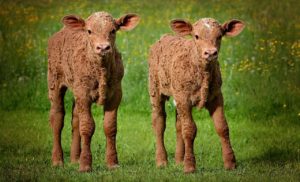Just 100 Days To Calving
18 January 2017 For many spring calving herds the start of calving is less than 100 days away. This makes it a good time to check the herd, or more importantly each cow, is on the right track for a successful calving.
For many spring calving herds the start of calving is less than 100 days away. This makes it a good time to check the herd, or more importantly each cow, is on the right track for a successful calving.
Cow Condition
Overfat cows, of which there will be more than normal this winter, must be grouped together and reduce their condition. In comparison the smaller number of lean cows might need to be gaining or at least holding condition. The target for every cow is a condition score of between 2 ¼ – 2 ½ three weeks before calving is due to start. The earlier calving start and the later turnout, the higher the target score.
In-Calf Heifers
It is likely that in-calf heifers will also be fitter than normal. They should be penned separately and targeted for a condition score of 2 ½ two weeks pre calving. For many this will require them to lose some condition while continuing to grow themselves. For heifers calving at two years of age, a target for rationing would be around 0.4 kg per day with any additional growth supported by them mobilising body reserves. Heifers calving at three years will already be almost fully grown, so target growth rates can be reduced to zero and even a small liveweight loss where they are excessively fat.
Vaccinations
If you routinely vaccinate against scour, what is the optimum time to vaccinate? Discuss with your vet. Better still if you have split the herd on expected calving dates why not vaccinate the late calving group later, on a date optimum to them? If they are already in a separate group this will involve little or no extra work but will maximise the effectiveness of the vaccine in late calvers.
Preparing Cows For Calving
Our recommendation is to start feeding additional magnesium, beginning 3 weeks before calving is due to start. (Where late calvers are split off this can be delayed until 3 weeks before they start.) The recommendation is to feed around an extra 5 g of magnesium per cow per day equivalent to around an extra 30 g per day of a standard high mag mineral. This is in addition to the min/vit supplement already being fed.
At the same time we also recommend introducing 0.5 kg of soyabean meal per cow per day to help ensure both the quantity and quality of the colostrum. This is particularly important in cows which have been mobilised a lot of condition over the winter and are likely to have lower body protein reserves.
With the majority of cows starting winter in extremely good condition, coupled with the low protein levels in many silages this winter, feeding soya pre calving could be even more beneficial next spring.
Plan Now For Groups Of Cows Post Calving
The traditional approach to regrouping cows as they calve has been to group them on calf age ie all the early calves in one group, later calves in another group, etc. The exception to this has been grouping first calved heifers separately so they can be fed better.
Consider making other groups of newly calved cows. A good example would be to put all definite cull cows in a single group. This will allow them to immediately be fed better (to allow them to be culled and sold earlier next autumn). In addition they can be easily turned out as a separate group without having to sort them out again.
In herds with a very short calving period, where at least two thirds of the cows could calve in the first 3 weeks would it also be sensible to group newly calved cows in terms of their eventual bulling group, as well as calf age? An alternative, where some calves are polled and others horned, would be to group them on that basis, to avoid having to handle all calves to dehorn just perhaps a few. However such options are only applicable in herds with a 9 week or less calving period as the target range in calf age in a group must be less than 3 weeks.
Basil Lowman, basil.lowman@sac.co.uk
Sign up to the FAS newsletter
Receive updates on news, events and publications from Scotland’s Farm Advisory Service
